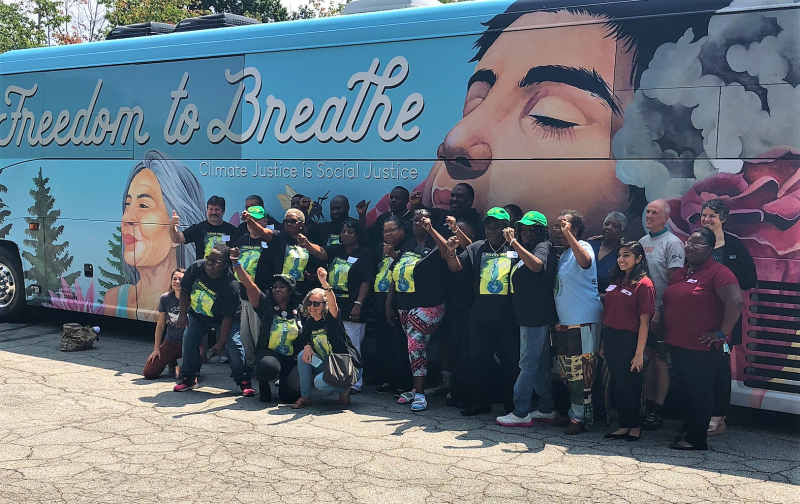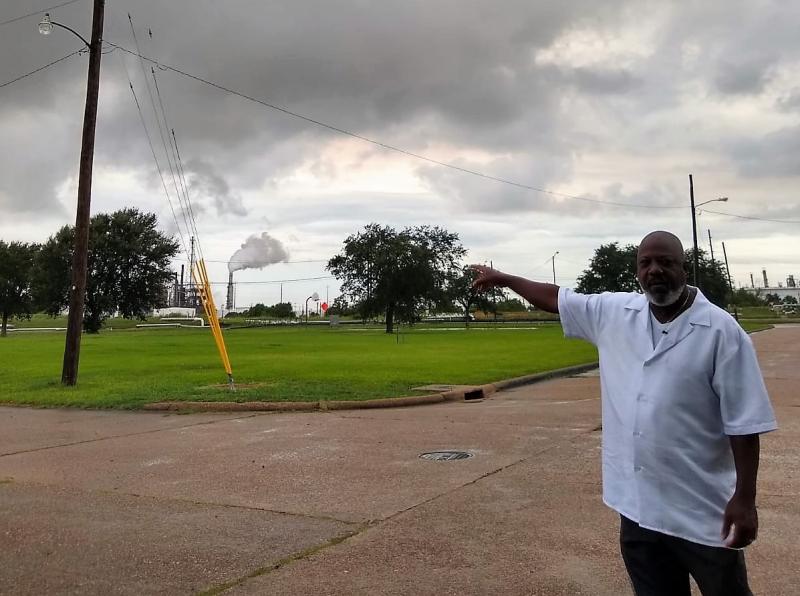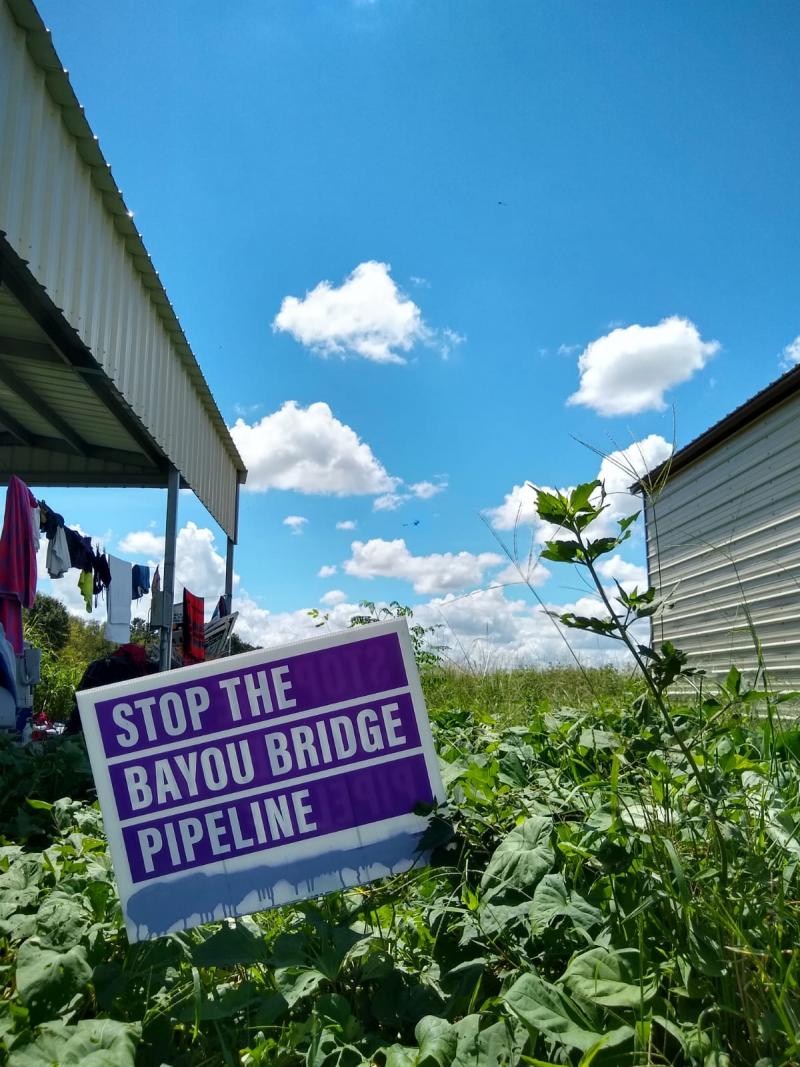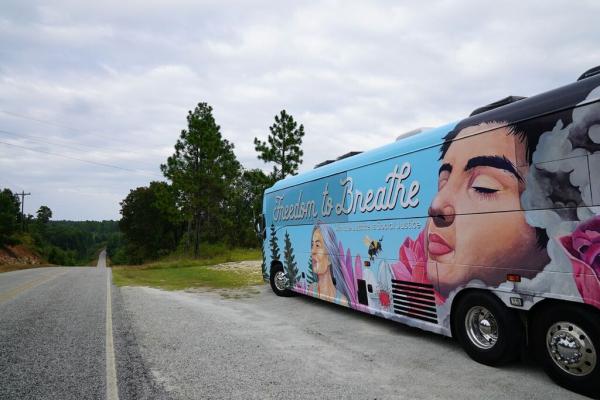On Sept. 12, government officials, business leaders, and scientists will convene in San Francisco for the first-ever Global Climate Action Summit.
As organizers and activists arrive by planes, trains, and automobiles to discuss best practices for addressing climate change, one group will be making an entrance in a bright blue charter bus.
Organized by a number of local and national partners, the Freedom to Breathe tour bus is a “vehicle for social change” and moving art installation. The bus has been on the road since Aug. 25, capturing the stories of climate leaders and organizers in impacted communities across the United States and sharing them out under the hashtag #FreedomToBreathe.
By the time the bus reaches its California destination, it will have logged a total of 5,000 miles, making stops in Florida, Alabama, Louisiana, Texas, Colorado, Nevada, and New Mexico.
“It’s really about what communities are already doing and have been doing,” an organizer of the tour told Sojourners. “The bus tour is just spotlighting their work.”
atlanta_town_hall.png

Dr. Neddy Astudillo, a Presbyterian pastor and GreenFaith’s Latin American Director, joined Freedom to Breathe on the first leg of the tour for a meeting with farm workers who are organizing around Lake Apoka, Fla., where pesticides, chemical fertilizers, and a nearby landfill incinerator have made the lake one of the most polluted in the country.
Astudillo said that many of the farm workers she encountered talked of experiencing extreme dehydration, dangerous heat levels, illness, and an inability to afford food, not to mention health insurance.
“These communities are already vulnerable because of an industrialized system that is based on exploitation of the land and exploitation of workers,” Astudillo told Sojourners. “In the midst of increasing storms and hurricanes, this is a community that doesn’t have enough support to be able to be resilient against climate change.”
Farm workers in Florida are just one example of how not everyone suffers equally when it comes to climate change.
Dr. Robert Bullard, often referred to as the “father of environmental justice,” points out that much of what people of color are experiencing in places like Lake Apoka and New Orleans are actually impacts of environmental racism.
“Environmental justice is all-encompassing and examines populations that are historically vulnerable,” Bullard explained. “Environmental racism looks at the policies and practices by government and industries that target people of color for dangerous, risky technologies, pollution facilities, and differential enforcement of environmental laws and regulations.”
hilton_kelly_port_arthur.jpg

While most people in the U.S. do not live next to a refinery, pipeline, or chemical plant, those who do are disproportionately people of color. It is these same communities that are often left out of mainstream environmental groups.
“All communities are not impacted the same by climate change and global warming,” Bullard added. “There’s certain populations, certain places, and certain communities that will feel the pain and the hurt of all the negative impacts of climate change and global warming first, worst, and longer.”
In many communities, breathing clean air isn’t a freedom, but rather a privilege reserved for those who have the financial means to move out or hire lawyers to plead their cases. But as cases of cancer, kidney disease, and asthma continue to climb at an alarming rate, the people are fighting back.
bayou_pipeline_camp.jpg

On Aug. 29, the Freedom to Breathe bus stopped in New Orleans to participate in a town hall organized by local women leaders to openly and publicly address the fact that women bear the brunt of environmental disasters.
“This is not just about recovering from Katrina,” Colette Pichon Battle of the Gulf Coast Center for Law & Policy said at the town hall held on the 13th anniversary of the hurricane. “This is about building a system of recovery for what we know is coming.”
From meeting with factory workers at the Sunrun Solar Company in Las Vegas to talking with water protectors protesting the Bayou Bridge Pipeline in Louisiana, the Freedom to Breathe tour has been intentional about spotlighting how communities are coming together at a grassroots level to counter environmental injustice.
“The one important part of the tour for us has been to highlight that it's not only doom and gloom,” one organizer said. “Wherever there's challenges, there's often people working toward solutions.”
Freedom to Breathe will share the stories and lessons they’ve collected at the Global Climate Summit as part of the We Are Still In Forum, a gathering of more than 2,700 American leaders who have committed to upholding the Paris Agreement for America. The bus will be parked outside; serving as a striking reminder of what could be.
For more information and videos of the tour visit freedomtobreathe.org.
Got something to say about what you're reading? We value your feedback!

